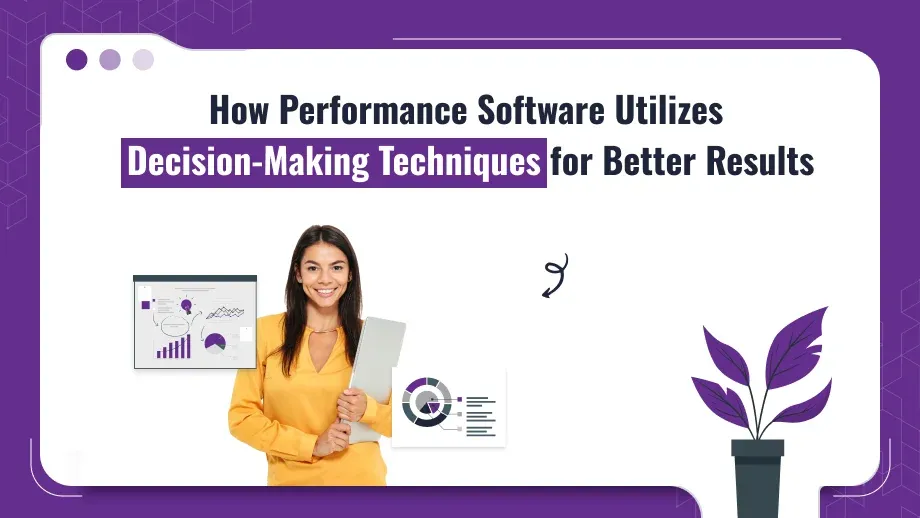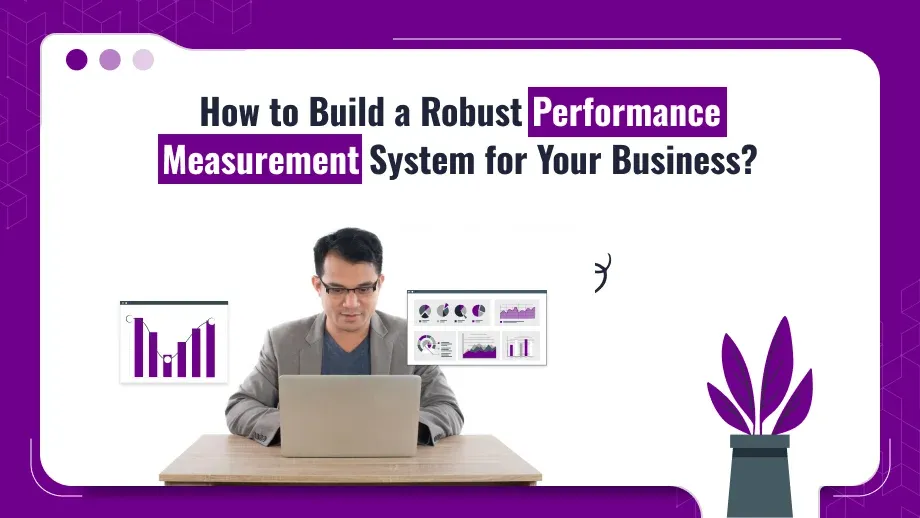
In today’s high-paced business environment conditions, decision-Making Techniques remain an essential and critical determinant in achieving success and sustainable growth in operations. At every organizational level, how to improve decision-making impacts the rate of productivity, resources available for exploitation, and strategy adopted by the firm. Performance software is there to support organizations in improving the effectiveness of their operations through maximizing their resources, coordinating efforts towards a strategic focus. Performance management enables the organization to make data-driven decisions to maximize performance and support scalability through various techniques of decision-making. This article demonstrates the various techniques of decision-making used in performance software, showing how these methods drive better results, support goal alignment, and foster long-term business success.
Significance of Decision-Making in Business Performance
Effective decision-making is a part of business operations; it does not dictate everything, from top-strategic planning to immediate functions. This ability enhances their capacity to deal with many complex issues, respond well to opportunities, and alter based on changes in marketplace conditions. For this end, productivity and performance provides ultimate help by giving tools along with insights that would enable organization persons to judge data with better performance and strategic choosing and monitoring.
It will capture the real-time information from numerous sources, ensuring that the user has a most up-to-date view of all key performance indicators besides other essential measures. These streams of information are paramount both to the process and to decision making techniques for the business.
All the trends and patterns in such performance can be pointed out, and any likely challenges can be foreseen way before they are able to grow into full-blown issues. Besides facilitating smooth communication between departments, this also ensures that all of the employees have access to correct information and are oriented towards the goals of the organization.
What are the techniques of decision making?
The use of data-driven decision-making eliminates guesswork or intuition and brings about more consistent and accurate results. Performance software points out the most relevant data points and presents them in an accessible format to ensure that decision-makers clearly view their options and take actions consistent with the company’s goals. The structured approach of decision-making is efficient, encourages alignment, and strengthens the organization toward the realization of long-term success.
Main Techniques Applied by Performance Software
Performance software contains some of the decision techniques in its own right to help achieve optimum efficiency, accuracy, and efficiency. Every technique has the power to lead business houses towards their target while offering a piece of insight regarding an aspect of performance and operation.
Data-Driven Decision Making techniques
The most straightforward approach will be good decision making. best decision entails making objective decisions based on data as opposed to assumptions, opinion, and instinct. It is allowed by performance software when it involves collecting, structuring, and analyzing volumes of data from different sources, ranging from employee performance records and financial metrics to customer’s feedback.
With the help of this software, it is possible to make choice decisions based on real-time insights to make sure each choice made results in aligned actual performance and business results.
Performance software presents this information in an easy-to-understand format, which forms a good basis for making decisions. The reliance of decision making methods on measurable information reduces the chance of error and bias, resulting in more consistent and reliable outcomes.
Ready to elevate your decision-making techniques?
Explore our performance software solutions and empower your team to make data-driven choices for sustainable growth!
Predictive Analysis and Forecasting
Predictive analysis is basically the technique applied in giving insight into what may happen in a future period using data extracted from history. Performance software with predictive analytics employs algorithms and models in statistics to give projection on what may happen through possible scenarios.
Forecasts complement predictive analytics by delivering projections of expected future performance based on up-to-date data. Since predictive analytics and forecasting both complement one another, then Performance Improvement Techniques will be more useful when it provides these two abilities to help firms understand exactly what is waiting for them and to undertake preemptive measures that achieve the envisioned goals. These will assure the decision makers have not only prepared for coming events but can also navigate an organization into the right place.
Relative Analysis
Comparative analysis is a technique whereby the business looks at performance metrics side-by-side to know which parts of the business are working and where improvement is needed. Performance software enables comparative analysis through benchmarking the current metrics against industry standards, historical data, or specific targets.
A comparative analysis allows the decision-making techniques in an organization to evaluate where it stands between doing great and doing very badly based on what the organization expects to achieve and possibly which organizations are referred to as competitors. Such a trend is highly instrumental when dealing with resource allocation within the business organization because one learns where efforts, time, and budget should be put into place to acquire the highest desirable outputs.
By implementing comparative analysis, performance software ensures that all decisions regarding the business organization are executed based on measurable information as this allows continuous development to achieve the maximum competitive position.
Scenario Analysis
Scenario analysis is a tool to help experts make a decision by comparing the expected outcomes of their decisions through consideration of various “what if” scenarios. Performance software provides scenario analysis in that it makes possible the presentation of the possible effects of various different techniques of decision making, which means that it allows decision-makers to compare the possible impact of any specific choice made. Scenario analysis is highly useful in risk management as organizations can predict probable challenges that may arise and evaluate the consequences of the alternative course of action taken.
There may be various outcomes for an event, and by having prepared for these outcomes in advance, decision-makers have reduced uncertainty and enhanced the reliability of their choices. Since business strategic planning involves evaluating a long-term goal and the objectives set by an enterprise amidst changing conditions, scenario analysis is useful. Performance software’s ability to create scenarios based on real data augments the accuracy of scenario analysis with well-informed better decision making set in accordance with organizational goals and objectives.
Optimization Modeling
Optimization modeling is the process of determining the most effective way that certain objectives can be met. Optimization modeling concerning performance software entails identifying places where processes may be streamlined or resources redirected towards improving efficiency. The technique of making a decision will help a manager make decisions because it indicates possibilities of reducing costs, increasing output or productivity without decreasing quality.
Optimization modeling enables a company to work at an optimal level with the minimal amount of waste. Since the performance software offers suggestions on change that can be made given the analyzed data, the decision-makers are able to allocate resources in a way that has the greatest positive impact. Optimization modeling is also scalable since it has the ability to give insights about how the organization could grow and change while being efficient and maintaining quality.
Stages in the Integration of Decision-Making Methods in Performance Software
The implementation of techniques to assist professionals in decision making in performance software requires a number of steps to translate insights into effective, actionable results. Such steps comprise a structured approach that guides the decision-making process and ensures each choice aligns with organizational goals and objectives.
Data Collection and Analysis
It all starts with data collection as performance software gathers information from several sources, such as operational metrics, employee performance records, financial statements, and customer feedback. Such data is categorized and put together for easy reference by the decision-maker, hence they can monitor the progression and patterns that might arise. Data collection is critical in establishing a holistic view of the organization because it provides the basis for analysis and decision-making techniques.
When performance data is collected, it is analyzed by software applications. This analysis helps decision makers to understand the facts with patterns and trends and eventually may have some issues of relevance. Data analysis stands out as the foundation that builds upon subsequent steps and action because it provides what decisions and operations need- direction and optimization.
Metrics selection
Right metrics will help for effective decisions. Performance software provides a rich set of metrics from the productivity rate to financial ratios, that enables the decision maker to pay attention to measures that create the most significant impacts in business goals. Since key metrics are the priority set by performance software, decisions get based on relevant data. This maximizes each of the choices that get effectuated.
The selection of metrics relates to the determination of organizational objectives and then the consideration of which metrics best inform progress toward the achievement of these goals. This in turn ensures that the processes involved in making decisions target areas that will have direct effects on performance and related outcomes.
Conclusion
Using advanced decision-making techniques is an important attribute of modern performance software. It would empower organizations to make smarter, more strategic choices to help them gain a real advantage in terms of execution and results. Companies will use data-driven insights, predictive analysis, comparative analysis, scenario modeling, and optimization to achieve accuracy and efficiency in accordance with goal setting.
The structured approach combined with technology enables business houses to be competitive, proactive, and agile in their efforts. The seamless integration of such decision-making tools and techniques into performance software helps achieve sustainable growth and operational excellence and long-term success in an ever-changing business environment.






